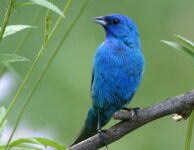
Make your garden a friendly rest stop for migrating birds
This time of year, gardens, parks and natural areas begin to fill with the songs and sights of migrating birds. More than 200 species of birds fly through the Chicago area every autumn, following Lake Michigan and the Mississippi River south for the winter.
“All those millions of birds need food and shelter along the way,” said Spencer Campbell, Plant Clinic manager at The Morton Arboretum in Lisle. “They may be on a journey of a thousand miles or more, and they depend on the trees and other plants in our forest preserves, neighborhoods and backyards.”
Trees provide sheIter, spots to rest, and feasts of high-protein insects to migratory birds including warblers, tanagers, tree sparrows, and rose-breasted grosbeaks as well as to birds that stay all winter such as woodpeckers, nuthatches, and cardinals. Scientific research has shown that urban areas with mature trees — including trees in yards and parkways — host more birds.
Shrubs, especially native species, often provide berries as well as insects. Perennials such as wild bergamot (Monarda fistulosa) and jewelweed (Impatiens capensis) offer nectar to migrating ruby-throated hummingbirds, while prairie flowers and grasses provide seeds to many kinds of birds.
Many homeowners enjoy the migrating birds that stop off at bird feeders. “That’s a great way to bring birds close to we can see them,” Campbell said, “but what we plant makes a much bigger difference to them.”
Here are some tips for a bird-friendly garden:
Care for mature trees. If you’re fortunate enough to have large, mature trees, keep them watered and mulched through the hot summer so they can have a long life providing shelter and food for passing and resident birds.
Relax about imperfections. “Holes in leaves are probably made by insect larvae, which means more food for birds,” he said. Spraying insecticides risks harm to birds that eat the insects.
Plant a buffet. Birds eat not just insects and seeds, but berries, buds, flowers, and nectar. Make sure you lay out the welcome mat with a variety of trees, shrubs, perennials and grasses that provide buds and nectar for the spring migration and seeds and berries in fall. For fall-flying nectar-sippers, consider marsh blazing star (Liatris spicata) and pink turtlehead (Chelone lyonii) as well as trumpet vine (Campsis radicans).
Focus on native plants. Midwestern birds have evolved alongside Midwestern plants, which are more likely to provide the right kind of food for them. For example, hackberry (Celtis occidentalis), a large native tree, supports more than 40 bird species with its fruits that ripen in fall and persist into winter. Eastern red-cedar (Juniperus virginiana) has berrylike fruits that feed dozens of kinds of birds, as well as evergreen foliage that offers protection from wind and weather. Oak trees feed hundreds of delectable kinds of caterpillars and other insects. Red chokeberry (Aronia arbutifolia), a shrub with white spring flowers, offers fall berries to chickadees, warblers and cedar waxwings, among other birds. Perennials such as pale purple coneflower (Echinacea pallida) and grasses such as little bluestem (Schizachyrium scoparium) and prairie dropseed (Sporobolus heterolepis) feed seed-loving birds such as goldfinches, tree sparrows and juncos. Discover more plants to support birds at mortonarb.org/plant-birds.
Avoid invasive shrubs. “The fruits of some woody plants such as Callery pear, buckthorn, barberry, and Japanese honeysuckle are attractive to birds, but that makes them destructive to natural areas,” he said. “These are non-native plants, and when birds spread the seeds, the plants grow to choke out native plants.” Learn about woody plants to avoid at mortonarb.org/invasive-plants.
Include late bloomers. Plant perennials such as native species of aster (Symphyotrichum) and false sunflower (Heliopsis helianthoides) that bloom in late summer and fall. “They’ll attract insects looking for nectar and pollen, and those may catch a hungry bird’s eye,” Campbell said.
Provide plants of many heights and shapes. If your yard includes tall trees, evergreens, large shrubs, and smaller shrubs as well as perennials and grasses, you’ll be providing shelter for a wide range of birds with different lifestyles.
Don’t be too neat. Let the fallen leaves lie under your shrubs and trees; birds love to hunt through them for bugs. Leave some plant stalks standing so insects can shelter in them. Collect pruned branches in a little brush pile where birds can hide and hunt.
Provide clean water. “Refill your birdbath often,” he said. Scrub it regularly so it doesn’t spread disease. “A beautiful garden can be even more lovely if it’s planned to be welcoming to birds,” Campbell said.
For tree and plant advice, contact the Plant Clinic at The Morton Arboretum (630-719-2424, mortonarb.org/plant-clinic, or plantclinic@mortonarb.org). Beth Botts is a staff writer at the Arboretum.



